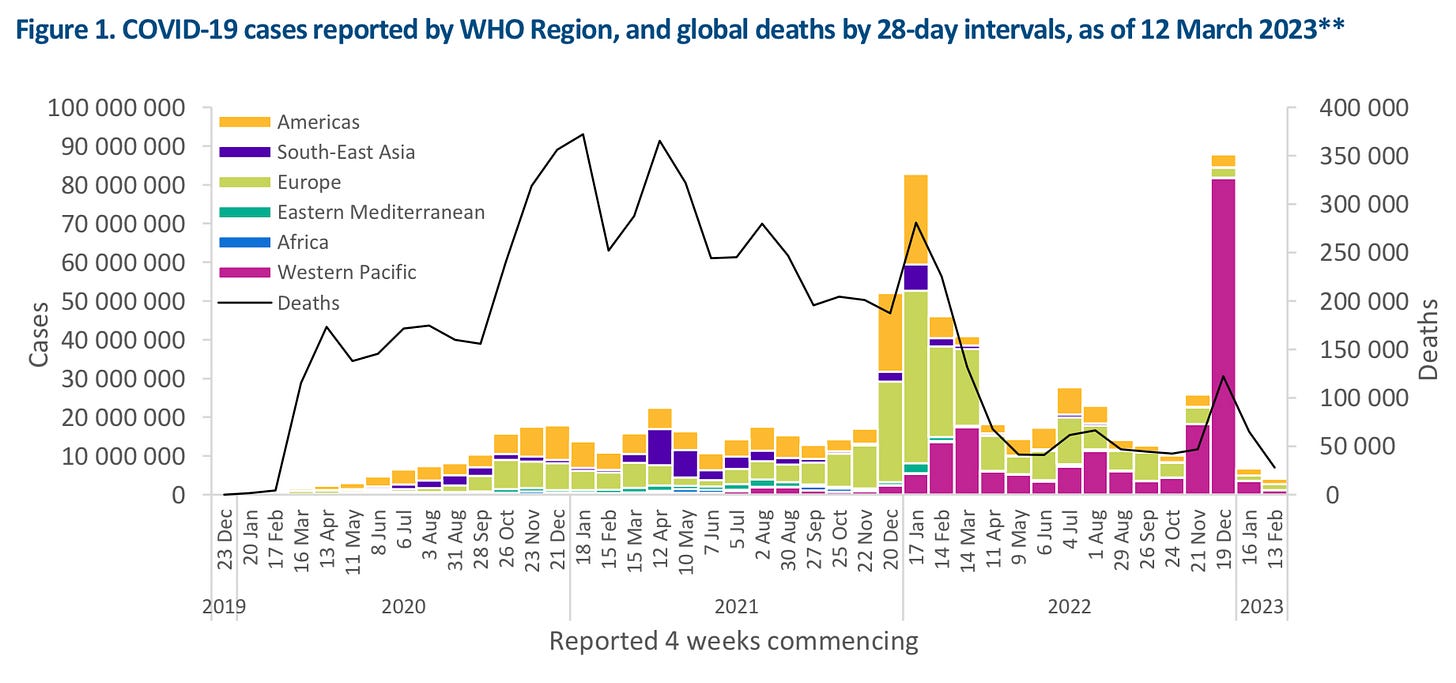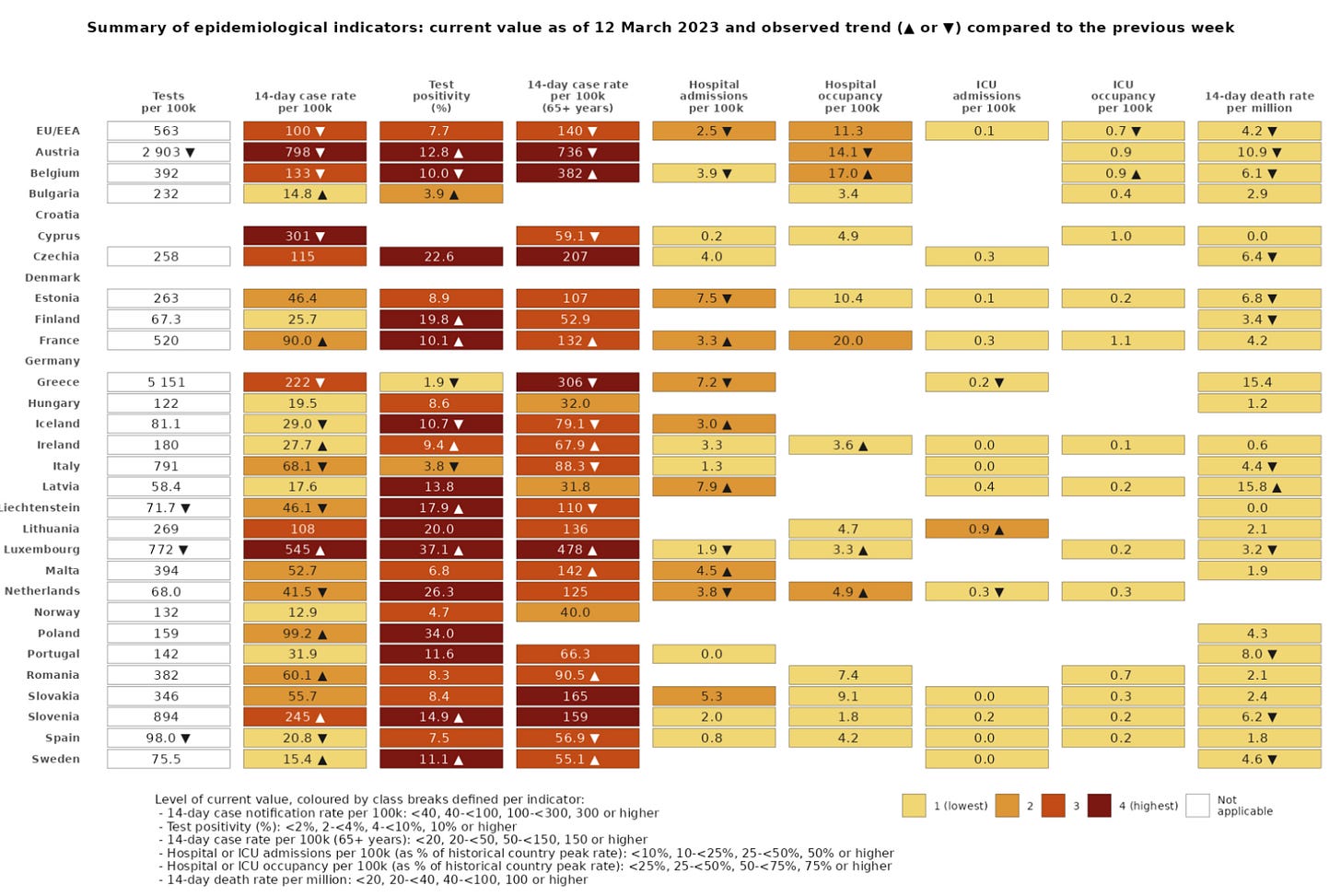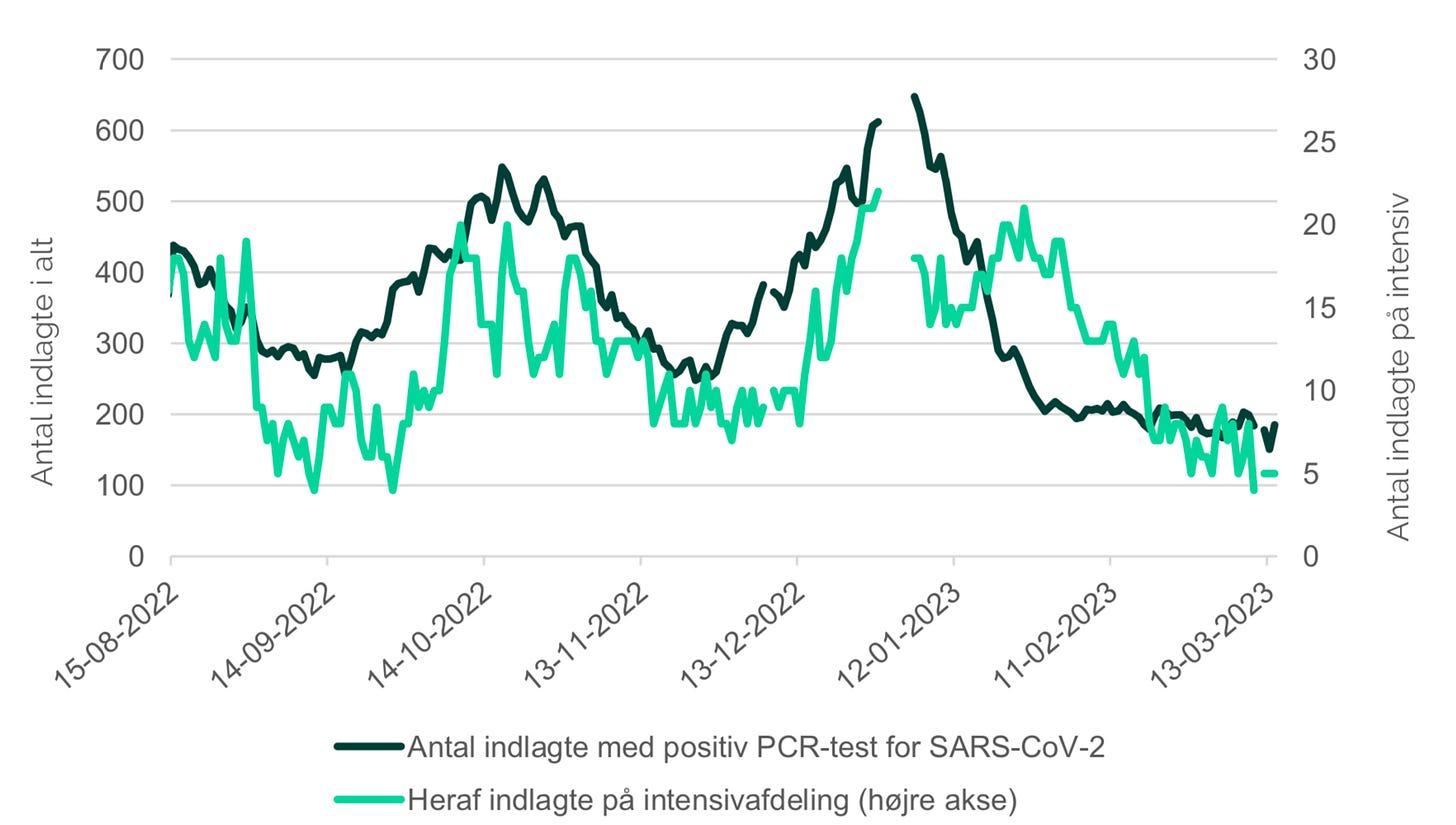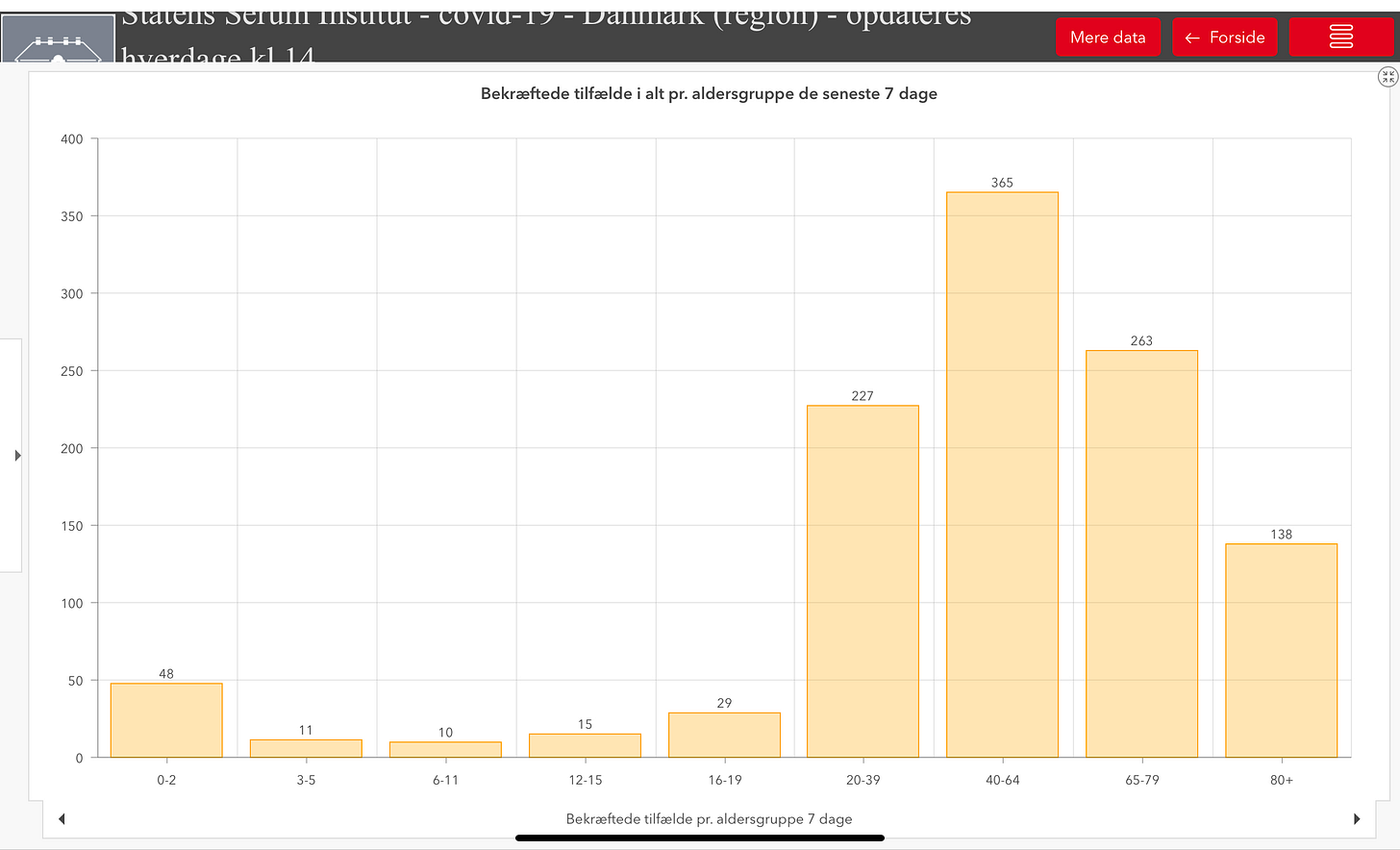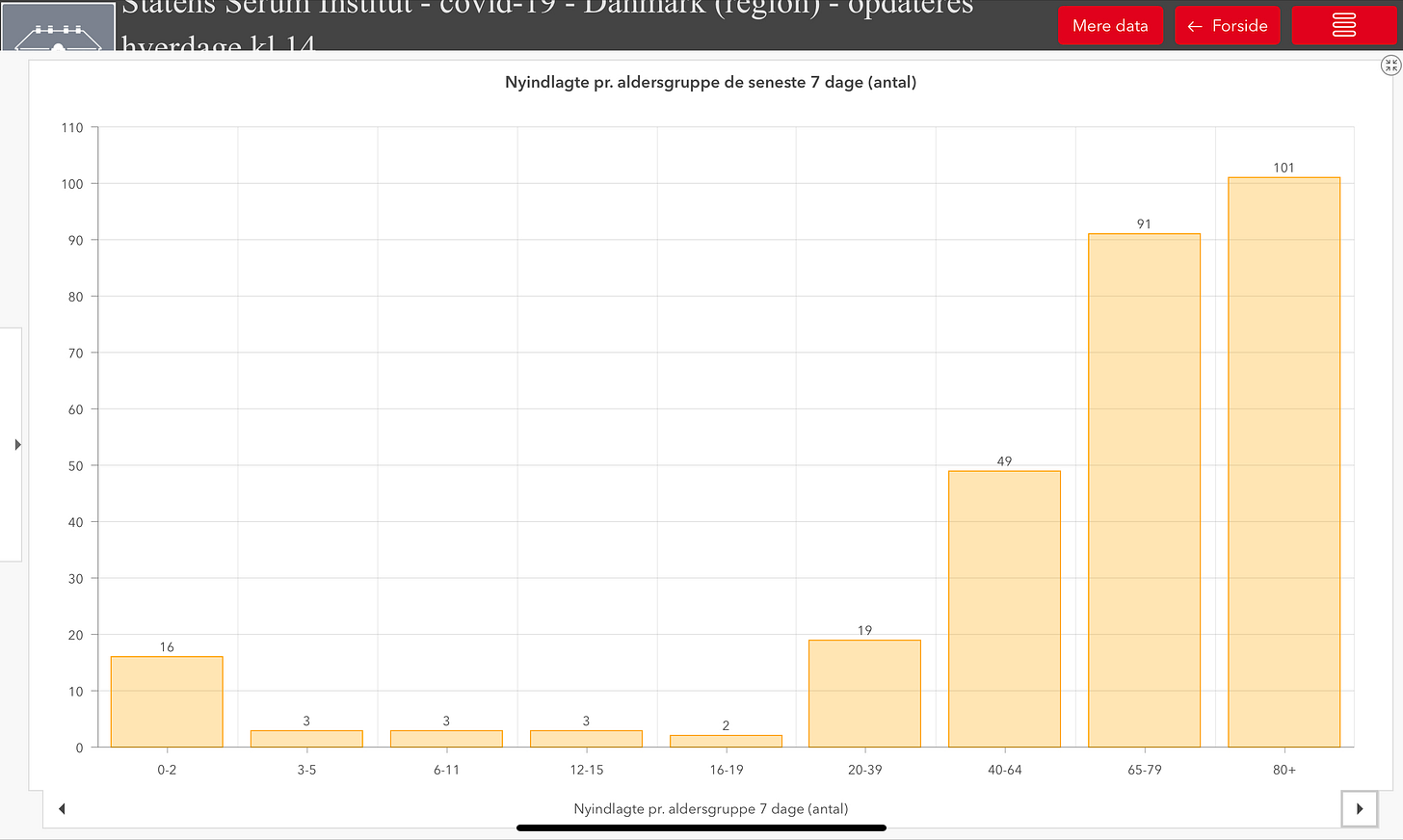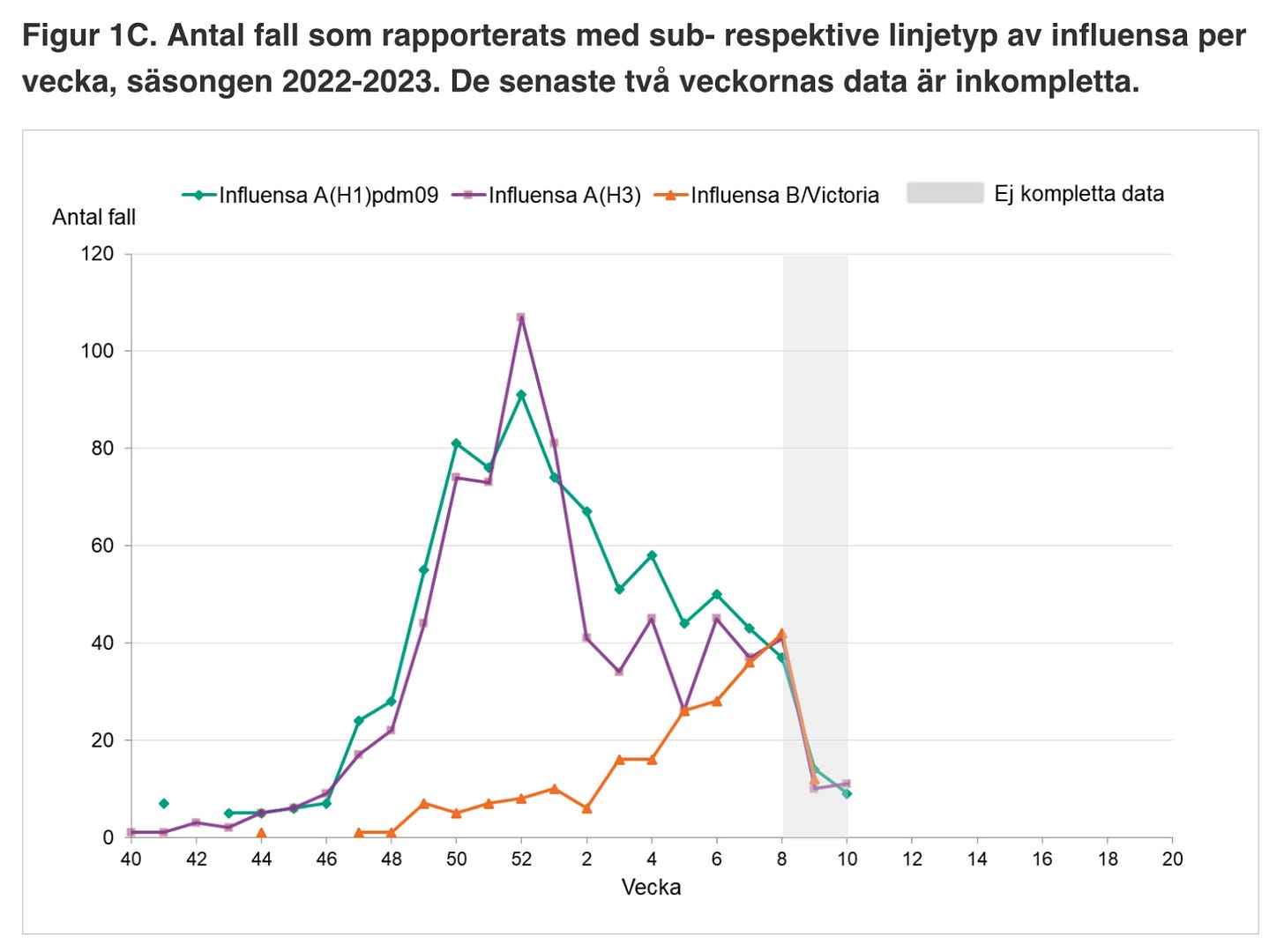Monday Morning News & Notes
A new variant emerges. Pandemic pressure eases on Danish hospitals.
🦠Pandemic🦠
🚨New Variant Alert🚨
XBB.1.16 is causing concern as a number of experts note it has mutations making it extremely contagious. It has been detected in at least 12 countries to date, including the United States, the UK, and India, where infection numbers are rising. On Saturday, new infections exceeded 1,000 in India for the first time since November. In the United Kingdom, the Health Security Agency has placed XBB.1.16 and two other recombinant strains on its variants under investigation and monitoring list.
🌍 🦠
Globally, COVID numbers continued their downward trend, but some potential signs of trouble emerge when you dig a little deeper. The latest WHO pandemic report says over a 28-day period ending March 12, there were nearly 4.1 million new infections (-40%) and more than 28,000 lives lost to the virus (-57%).
“However, there are significant regional differences including increases in some regions.”
The global health agency also continues to hammer the point home that with testing and sequencing numbers dropping like a rock, it has become very difficult to get an accurate pandemic picture.
“Current trends in reported COVID cases are underestimates of the true number of global infections and reinfections. This is partly due to the reductions in testing and delays in reporting in many countries.”
Across the six WHO regions, infection activity increased in Europe (+20%), Eastern Mediterranean (+18%), and South-East Asia (+14%) while they fell in the remaining three. COVID deaths increased in just one region, the Eastern Mediterranean (+35%), while they dropped significantly in the other five.
At the individual country level, the United States continues to lead all nations on earth in new infections with 919,961 (-21%) and deaths, with another 9,303 American lives lost (-35%). Japan also continues to be a coronavirus concern with 380,898 new cases (-77%) and 2,598 more deaths (-77%), as is China, with 370,020 infections (-71%) and another 1,586 fatalities (-92%).
Russia is seeing increasing coronavirus activity, with 350,376 new infections (+62%), as is Germany, with 338,306 new infections (+10%).
The WHO says just 65,348 sequenced positive tests were submitted to GISAID in the latest 28-day reporting period. Of those, the recombinant XBB variant and its 25 and counting sub-variants continue to increase, with the XBB.1.5 strain being the most active. It has now been detected in 115 countries and is now the dominant variant in five of the six WHO regions.
“XBB.1.5 does show a growth advantage and a higher immune escape capacity, while evidence from multiple countries does not suggest that XBB and XBB.1.5 are associated with increased severity or mortality. In countries where the variant has driven an increase in cases, the waves are significantly smaller in scale compared to previous waves.”
-
The WHO is doing some housekeeping to make its tracking of the different COVID variants a little less confusing. It had initially named each new variant after a letter of the Greek alphabet, but since the Omicron strain arrived over a year ago, it and its many sub-variants have dominated virus activity. Because these are all Omicron strains instead of new Greek letter designations, it has been an endless stream of letters and numbers like BA.2, BA.4, BA.2.75, and now the recombinant XBB strains.
So to make a long story short, the WHO Omicron sub-variants will now be tracked independently. Greek letters will only be used for any variant deemed to be a variant of concern because it presents a threat that requires major public health interventions. Variants of interest will not be given a Greek letter.
-
Another potential culprit has been identified as possibly causing the COVID pandemic. Theories have abounded around the Wuhan wet market to a potential laboratory leak but, to date, we still don’t definitely know what triggered the pandemic. The World Health Organization revealed on Saturday that Chinese authorities recently submitted a treasure trove of data containing new information about animals that were present at the Wuhan wet market. The new data suggests that raccoon dogs, and some other animals, were present and/or being sold at the market.
“Although this does not provide conclusive evidence as to the intermediate host or origins of the virus, the data provide further evidence of the presence of susceptible animals at the market that may have been a source of human infections.”
Raccoon dogs are a species that is susceptible to coronavirus infections but were not previously known to be sold at the market. Nor were they in any of the animal testing previously submitted from Wuhan where the pandemic began more than three years ago.
🇪🇺🦠
There were no major changes in Europe’s pandemic situation last week, according to the latest snapshot from the European Centre for Disease Prevention and Control. Overall, infection activity across Europe didn’t increase and COVID indicators “remained at relatively low levels.”
For a second straight week, pandemic deaths across Europe continued to decline. There were still 478 lives lost from the 24 countries reporting coronavirus deaths.
Zooming down to the individual countries, seven of the 25 countries submitting infection data by age (Sweden, Belgium, France, Ireland, Romania, Malta, and Luxembourg) saw rising numbers of cases among seniors over 65. In three of those countries, deaths have been increasing for up to six straight weeks.
Hospitalizations or intensive care admissions have increased in nine of the 22 countries reporting admissions data. France, Iceland, Latvia, and Malta saw admissions rise. Hospital occupancy increased in Belgium, Ireland, Luxembourg, and the Netherlands. While Belgium was the lone European country to see intensive care numbers rise.
Pandemic deaths rose in just one country, Latvia.
The ECDC notes that countries seeing increasing COVID numbers all have one thing in common, a dominant XBB.1.5 variant.
Just five countries are now testing and sequencing in numbers large enough to derive any useful pandemic information. Of those, XBB.1.5 accounted for 45.9% of infection activity, while BA.2.75 was responsible for 18.7%, and in 15.3% of cases, it was the BQ.1 variant.
Uptake for a second booster dose and the protection it offers continues to be uninspiring across Europe. Just 17.3% of those over 18 have a 2nd booster shot, while a mere 35.5% of vulnerable seniors over 60 have another booster.
🇩🇰
According to the latest hospitals status report, pandemic pressure on Danish hospitals has eased significantly since the new year began. It says overall respiratory infection-related hospitalizations continue to drop. COVID admissions are “low and stable,” with around 200 people or fewer admitted daily. The number of severely infected people is much lower than it has been previously in the pandemic.
The report says influenza-related hospitalizations are also decreasing and should continue to do so. At the same time, RS-virus-related admissions are now so low that the infection wave is deemed to have come to an end.
-
Despite a hefty financial investment, a made-in-Denmark COVID vaccine candidate is being taken off of the table. The Statens Serum Institute says development of its COVID DNA vaccine, Covaxix-351, is being discontinued because the coronavirus “is no longer considered a socially critical pandemic” and that other effective mRNA vaccines are on the market. Ultimately, the institute says a DNA-based vaccine against COVID was no longer considered relevant.” This despite a 23 million Danish kroner investment (about $4.5 million Cdn) that had taken the vaccine to the cusp of human trials.
SSI Director Henrik Ullum said the process had given his agency valuable knowledge on the rapid design and development of a safe and effective vaccine candidate.
“Although it is, of course, a shame when you do not quite reach the goal with a study and a venture, it is nevertheless against a happy background that we are stopping the project. After all, there have been many positive developments in the pandemic and where we are now and by the fact that effective mRNA vaccines came onto the world market so quickly. And in that situation, it is prudent to stop now and limit further expenses for the project.”
The institute says that Covaxix-351 had just completed a toxicological study, the last step before human trials. The needle-less vaccine technology under development had, up to this point, proven to have produced protective antibodies and cell immunity against infection.
-
Vaccination uptake was sky-high across Denmark, according to the Danish National Health Board’s last vaccination status report, until the new booster dose campaign begins this fall.
In the most recent vaccination effort that began last September, a total of 3.7 million vaccinations were administered. 1.9 million were COVID vaccines. 1.6 million were flu shots, and 170,000 were vaccinated against pneumococcal disease.
Section Manager Kirstine Moll Harboe:
“When we look back on this year's vaccination efforts, we are very satisfied. We were curious whether the population would again accept our vaccination efforts as the pandemic dragged on, and luckily they did. Together with general practitioners and private vaccination companies, the regions have succeeded in making vaccinations widely available. A record number have gotten vaccinated, and it has prevented both severe infections and death and protected our healthcare system.”
Vulnerable seniors over 85 led the way with a COVID vaccination uptake of 91%, while 82% also received a flu shot. Among seniors in care, 92% had another COVID booster dose, and 85% also had a flu shot.
The health board says Denmark has the highest uptake among seniors over 60 of any of its Nordic neighbours and across the entire EU.
-
Infection trends haven’t changed in Denmark in the last seven days, but the overall numbers have increased. The lion’s share of new infections remains concentrated in the over-20 age groups, with those 40 to 64 years old seeing the highest number of new cases. Week to week, the numbers have increased for infants under two, 20 to 39-year-olds, those 40 to 64, and seniors 65 to 79.
-
67% of all COVID hospitalizations in the last seven days have been among seniors over 65. That number increases to 84% when you include the 40 to 64-year-old age group.
-
Another sign of a return to normal in Denmark. The Ministry of Education says the latest university intake has received 51,944 admission applications, about 3,000 more than the same intake last year.
Director of the Danish Agency for Education and Research Mikkel Leihardt:
“This indicates a normalization after a few years when the search has been clearly affected by COVID. The shutdown of society and the limited opportunities for, for example, travel abroad and employment resulted in record intake in 2020 and 2021 and then a drop in 2022.”
🇸🇪
The steady decline of COVID infections in Sweden seems to have significantly slowed, according to the country’s Public Health Agency. From what Sweden can see with its extremely restrictive testing, cases have been falling since the beginning of the year. The agency blames the recombinant XBB.1.5 variant for driving new infections back upward. The coronavirus strain has proven to be more contagious but hasn’t yet shown any indication it causes more severe infections.
-
Cases of unusually severe influenza infections among young people under 18 have prompted the Swedish Public Health Agency to launch an investigation. In Region Örebro län, healthy young people have become very sick with the influenza B strain and then suffered complications like myocarditis or encephalitis. The agency says these cases are “very unusual,” and it has now cast a wide net across Sweden and the European Union to see if there are any other similar unusually severe flu infections out there.
Region Örebro län has also begun offering school children free influenza vaccinations as a precaution.
The public health agency says the influenza B strain has been to blame for more than half of all flu-related hospitalizations in Sweden over the past few weeks. Overall, flu cases declined by 8% last week in Sweden, but the declines were almost entirely among influenza A strain infections.
🦠 📚
A large study in the United States is helping to peel back the many mysteries of long-COVID. The study had more than 800,000 participants and found that the people most likely to suffer from long-COVID are seniors and women. The Health Affairs study also found that high blood pressure, chronic lung disease, obesity, diabetes, and depression were all leading risk factors for long-COVID.
Harvard Medical School Associate Professor, and lead author of the study, Zirui Song:
“This work in a large population helps to address the question of who is more at risk of long COVID. This may help clinicians and healthcare organizations screen, monitor, and treat patients more effectively. It may also help individuals, who know their own medical history, better assess their risk of long-COVID and the value of protecting against getting COVID in the first place.”
The study also found that long-COVID symptoms can persist for up to a year.
“Clinicians and the public health community are working hard to understand who this condition afflicts, what causes it, and its health and societal consequences.”
The study can be found in full HERE.
⚡️Energy Crisis⚡️
🇪🇺/ 🇳🇴
The European Union is doubling down on its reliance on Norway for its energy exports. The EU and Norway have agreed to work more closely together on the green energy transition. On Friday, European Commission President Ursula von der Leyen met with Norwegian Prime Minister Jonas Gahr Støre and NATO Secretary-General Jens Stoltenberg on the Norwegian offshore gas platform in the North Sea. The EU and Norway agreed to partner on green energy productions, including offshore wind, green hydrogen, and other renewables.
Ursula von der Leyen spoke to Ritzau:
“Norway has been a very important partner and friend in the last 12 months during Russia's terrible war in Ukraine. Putin stopped 80 percent of the gas to the EU, but Norway stepped in and increased its production. It helped us at a critical time.”
Norwegian Prime Minister Jonas Gahr Støre promised that Norway would be a more reliable energy supplier to Europe.
The presence of the head of NATO also sent an important message that the military alliance will defend the energy infrastructure its member countries rely on.
🇩🇰
According to the Danish Energy Agency about 10,600 homes in Denmark erroneously received a heating rebate check for 6,000 Danish kroner (just under $1,200 Cdn). But, a Ministry of Climate, Energy, and Supply document says just 17 households have returned the money. Work is underway to explore options for a voluntary repayment plan for the rest.
During the height of the energy crisis last summer, when prices were skyrocketing, the Danish government sent out home heating rebate checks to try and blunt the pain. A registry error led to some checks going to households that did not qualify for the rebate.
🇺🇦/ 🇷🇺 War
ICC/ 🇷🇺
On Friday, the International Criminal Court issued arrest warrants for Russian President Vladimir Putin and Russia’s Commissioner for Children’s Rights, Maria Belova. The pair are facing war crimes charges for illegally abducting Ukrainian children and taking them from Ukraine into Russia.
You can watch the statement from ICC President Judge Piotr Hofmánski below.
Russia, and other countries like China and the United States, do not recognize the power of the International Criminal Court and have no domestic legal compunction to comply with its arrest warrants. That said, U.S. President Joe Biden calls the arrest warrant for Vladimir Putin “completely justified.”
Other countries do, though, including South Africa, where Putin is scheduled to visit later this year. While Russia has dismissed the ICC arrest warrants, Putin must be very careful about where he travels now.
🇹🇷/ 🇸🇪 🇫🇮
Finland took a huge step forward on Friday to finally join the North Atlantic Treaty Organization. Turkish President Recep Tayyip Erdogan, alongside Finnish President Sauli Niinistö, announced that he officially endorsed Finland joining NATO and that Turkey would begin the parliamentary ratification process. Erdogan said that the vote should be held before the end of April.
While Finland moves to the cusp of NATO membership, Sweden is remains out in the cold. Erdogan continues to play hardball.
“We do not have a different approach to Sweden, but Sweden has embraced the terrorists. When they do not give us these terrorists, it is not possible for us to approach Sweden positively. That is why we had to separate Finland from Sweden.”
Erdogan remains upset about members of the PKK, the Kurdish Workers Party, that fled to Sweden. Turkey’s efforts to extradite some of the most wanted PKK members have been stonewalled by the rule of law, with the country’s highest court blocking Turkey’s extradition requests.
Finnish Prime Minister Sanna Marin addressed the elephant in the room in reacting to the good news for Finland.
“An important step towards Finland's NATO membership has been taken today when Turkey announced that it will start the ratification process in the parliament. Finland will do everything possible so that Sweden also becomes a member of NATO as quickly as possible. Together we are stronger.”
The reaction from Sweden’s Foreign Affairs Minister Tobias Billström to Turkey endorsing just Finland was succinct.
“It is a development that we did not want.”
Meanwhile, Finland’s Foreign Affairs Minister Pekka Haavisto said his first call after returning from Turkey was to his Swedish counterpart.
“Good telephone conversation with my Swedish colleague Tobias Billström after returning from Ankara. Working together so that Finland and Sweden could be members of NATO before the Vilnius Summit.”
🇭🇺/ 🇸🇪 🇫🇮
As for Hungary, while Prime Minister Viktor Orbán keeps saying he and his governing party support both Sweden and Finland’s NATO applications, the Hungarian parliament has postponed the ratification vote several times. And now, another twist. Parliament has called a ratification vote for Finland on March 27. As for Sweden? It says parliament will decide “at a later date.”
🇺🇸 🇸🇪 🇫🇮/ 🇭🇺 🇹🇷
The United States has reportedly been very active behind the scenes putting pressure on Turkey to support Sweden and Finland’s NATO bids. Turkey desperately wants to upgrade its Air Force to American F-16s. The U.S. could be using this as leverage. After Turkey announced its support for Finland, the White House issued a statement calling for Turkey and Hungary to expedite ratification votes for the two Nordic nations.
“Sweden and Finland are both strong partners who share NATO's values and will strengthen the alliance and contribute to European security. The US believes both countries should be admitted to NATO as soon as possible.”
🇪🇺/ 🇷🇺
Russia continues to test the limits of European air space. On Saturday, British and German Typhoon fighters were scrambled again to intercept Russian aircraft near NATO airspace over the Baltic. The Russian aircraft included two Su-27 Fighter Jets, one An-12 Military/Cargo Transport, and one Tu-134 VIP Transport.
🇩🇰/ 🇺🇦
The Danish military is being coy about how many Ukrainians have been through military training programs in Denmark. The Chief of Defense, Flemming Lentfer, spoke to Ritzau but would only say a “three-digit number of people from Ukraine” have been in the country for military training.
“What we are doing right now is training for artillery systems. Then we have mine clearance training both on land and at sea.”
Denmark recently donated all 19 of its CAESAR artillery systems to Ukrainian forces, and it is those they are being trained on right now. But other members of the Ukrainian military have also been to Denmark to receive instruction on what is only being called “various courses.”
-
Next week, Denmark will host the largest artillery exercise seen in the country in the last 30 years. The country will host the Dynamic Front military training combining artillery, fighter jets, and warships in an exercise aimed at streamlining communication among the different allied countries to hit enemy targets more effectively.
Major General Gunner Arpe Nielsen says the exercise will combine American HIMARS rocket launchers, Danish heavy mortars, and howitzers from France and Poland. All of this alongside air support from American warships and F-16s.
“Fire support is crucial for the ability of military land units to fight. It is, therefore, crucial for the NATO alliance that the countries can effectively use each other's fire support systems. In Ukraine, we, therefore, see a very large use of both tube and rocket artillery from both sides.”
An essential part of the exercise is that the artillery units train on the Artillery Systems Cooperation Activities system, allowing allied units to communicate effectively and quickly despite language barriers.
“The ability to understand each other's procedures and that our systems can technically communicate and work together across nations is crucial in a crisis situation. The aim is that in a crisis, you can use each other's artillery systems, aircraft and other means of fire support. It is only possible if we meet regularly and train the common procedures in NATO.”
The exercise will involve over 500 soldiers from eight different countries.
“One of the significant contributions from Denmark to NATO's collective defense is that Denmark can function as a receiving country for NATO forces. When a unit arrives in Europe and is assembled with allied units, it needs to make the final preparations before it can be deployed in a crisis situation. The armed forces will use the Dynamic Front exercise to train how we can receive and create the framework for such exercises for other countries' units in Denmark.”
Dynamic Front will take place over a few days at Oksbøl beginning on March 27th.
🇵🇱/ 🇷🇺
A Polish counterintelligence unit claims to have busted a Russian spy network it says was trying to disrupt allied weapons shipments to Ukraine.
Poland’s Minister of the Interior, Mariusz Kaminski, says nine people have been arrested.
“The detained persons carried out intelligence activities against Poland and planned sabotage at the behest of a Russian intelligence service.”
Western countries sending arms shipments to Ukraine often funnel the deliveries through Poland. Those shipments were apparently the target.
“We have seized cameras, other electronic equipment, and GPS transmitters which were supposed to be planted on the emergency aid to Ukraine.”
Six of the nine people arrested are now facing espionage charges.
🇸🇰/ 🇺🇦
First, Poland, now Slovakia, has also announced it will donate 13 MiG-29 fighter jets to Ukraine. Slovakian Prime Minister Eduard Heger made the announcement on Friday. Slovakia will also donate Soviet 2K12 medium-range air defense systems to Ukraine.
🇩🇰/ 🇺🇦
Denmark won’t go it alone if it comes to donating fighter jets to Ukraine. Acting Minister of Defense Troels Lund Poulsen told DR that Denmark would only do so as a coalition of countries.
“If we in Denmark are going to discuss combat aircraft, then we are going to do it with other countries. Because Denmark cannot do this alone.”
Late last week, Danish Prime Minister Mette Frederiksen said the countries supporting Ukraine are constantly discussing ways to maintain support across a number of fronts.
🇸🇪/ 🇬🇧/ 🇺🇦
Sweden and the United Kingdom reached a deal last week that will see Sweden sell its Archer mobile artillery systems to the UK, which will, in turn, then send Ukraine its older AS90 self-propelled artillery platforms.
The Swedish Government says 14 Archer units are headed to Britain, where they will help fill the gap left after sending Ukraine 32 AS90s.
Sweden has previously donated eight Archer artillery systems to Ukraine.
🇧🇪/ 🇺🇦
240 Volvo-made military trucks are headed from Belgium to Ukraine. The first shipment is expected to be dispatched this week. The vehicles will be used by Ukraine to transport troops and equipment to the Eastern front. The Belgian Defense Ministry says while there is often a focus on weapons donations, logistics are equally important, and Ukrainian forces need these vehicles.
The Volvo vehicles are reputed to be easy to repair and maintain, meaning they can be handed over to Ukrainian forces without any special training.
🇨🇦/ 🇺🇦
Canada is transferring armoured recovery vehicles to Ukraine. Canadian Defense Minister Anita Anand took to social media over the weekend to say that more help is coming.
“More Canadian military aid is en route to Ukraine. We’re providing an armored recovery vehicle to help Ukraine sustain the heavy armour that we’ve donated. Ukraine will win, and we will stand with Ukraine for as long as it takes.”
The vehicles in question appear to be Bergepanzer 3A1 Armored Recovery Vehicles, which evacuate troops, clear obstacles, and tow heavy armour. The minister didn’t specify how many vehicles are on the way to Ukraine from Canada.




